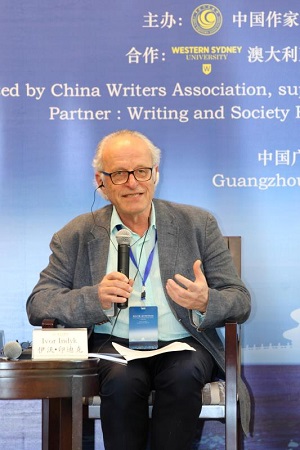伊沃·印迪克:在澳大利亚做文学出版商

在澳大利亚做文学出版商
正如英国小说家劳伦斯·斯特恩所说,“每个人都会谈及市场是因为他自己的买卖存乎其中”,就我而言,我作为独立的文学出版商,总是和世界范围内其他出版商及其商业动机存在分歧。我不知道在中国情况如何,但在澳大利亚,通常一个作品的文学价值与商业价值之间存在着反比关系。也就是说,一本书越具文学性,那么其销量就会越少。当然有例外,但这种例外并不多见。吉拉蒙多出版社的诗人没法仅仅靠出书存活;大多数的散文作家也是如此——他们不得不另谋出路以维继写作生涯。
如果文学作家难以生存,那么文学出版商也难以为继。一套备受推崇的诗集可能会卖出500本;即便是一部拍案叫绝的文学小说甚至也只能卖出2000本。我出版过一位获得诺贝尔奖的作家的书,最多也只卖出了1500多本。在这种情况下,一个出版商的存在是在践行一种似乎不可能实现的艺术价值--我应该说完全不可能,因为商业性出版的正常预期是得到利润回报。在我国,这往往意味着获得利润回报的是在其他国家的母公司。
在我成为出版商之前,我是澳大利亚文学界的学者和评论家。现在我依然如此,可以看到我的评论和出版活动之间存在一种连贯性。,对我而言,出版的确是一种评论行为。正常情况下,在一本书出版之后,评论才会出现,有时需要等待多年。。但我认为出版作为一种评论行为,应该存在于既成事实之前,即某一本书出版之前,并伴随着整个出书过程。我认为,从这一意义上讲,评论包含了从一开始的选作到出版整个过程中与作者合作完成的所有活动,目的是确保实现作品的文学价值,当然也包括了对作品进行编辑。事实上,作为出版商,我面临的最艰巨的任务之一就是在书的封底写上150个字的描述。这就是英语所谓的“荐书评论”,因为它会对该书大肆宣扬,却对其意义只字不提。我努力避免夸张并提供对书的解读,强调其对澳大利亚文学写作的贡献。用150个字来实现对一本书意味深长的解读是相当困难的,这甚至少于如今在澳大利亚报纸上发表评论所允许的字数上限——800个单词。
我认为自己是一个“概念性”的出版商,而不是商业出版商。这是因为,当我出版一本书时,我所关注的概念总是超过这本书或作者,即关注澳大利亚文学的概念;或更笼统的,关注整个文学的概念,甚至更理想化的,关注我们的子孙后代。幸运的是,确实有机构——澳大利亚艺术委员会、版权代理有限公司、州政府的艺术部门以及大学等支持这些宽泛的工作理念,并为此提供资金支持,或是直接资助,或是将我们的书列入课程教材。澳大利亚也有很多文学奖,支持了文学出版商从概念上而非商业上去思考问题。
在条件有限的情况下,为了能在概念性的出版或理想化的出版中留有一线生机,就必须进行战略性思考。在一定程度是因为要说服投资者一如既往地资助你,那么你必须满足他们的目标和关注重点以及管理方面的要求。但是,你所服务的对象,即文学思想或概念也要求你要进行战略性思考,因为文学思想或概念总是不断变化,不会始终静止,很有可能某种程度上由于你自己的贡献而在发生变化。
关于这一点,我想举两个例子,谈谈我最近在吉拉蒙多出版社一直在采取的战略。我希望能够更清楚地解释概念性出版的含义,即时刻铭记文学的大概念。首先关注澳大利亚新一代的新兴作家,他们现在30多或40岁刚出头,大多数在学校或大学学习过古典文学课程,而这些课程都被现代其他“文本”形式替代:电影、电视剧、流行音乐歌词、艺术品、高雅作品和流行文化作品。与此同时,由于互联网包罗万象,可以满足人们各式各样的好奇心,日新月异的数字技术,例如博客、电子杂志以及其他自媒体手段,为年轻的准作家们提供了史无前例地迅速发表和分享作品的机会,
在这种背景下,阅读和写作的价值不降反增,尽管大部分人起初不这么认为。与之相反的是阅读的习惯则发生了改变,读书被日常生活中的碎片阅读所替代,包括博客和电子杂志的内容,再到诗歌、脚本、习俗,甚至是密切审视人际关系。痴迷的力量是文学创作的源泉,且不容小觑——新的数字环境完全适合于培养痴迷的态度。此外,新技术也使写作的影响范围空前扩大。年轻的这一代作家中的佼佼者在为新书发表做准备的过程中,不分昼夜,奋笔疾书,年复一年。而这种写作的目的就是为了流通,不管其读者群大小,一旦完成写作,即刻进行发表的状态当中。
这种过于数字化的写作有其优缺点。文学出版商不仅仅面临一种偏见:如何将这种新型写作的优势与文学传统联系起来,即使作者可能不会直接认识到这种联系,也可能不会将这些传统界定的重要作家及作品列入参考文献。诚然,这是评论和解读的主要任务。采取借用、取样、引用、例证和其他自己可用的美学技巧,对已有的体裁加以无拘无束的组合:自传和小说、诗歌和散文、叙事和纪实。这种写作中的“声音”非常强大,正如人们所期待的一样,使得我们很难分清作者、叙事者和作品中的人物。而这种区分恰恰是现代文学评论的基础,至少英语国家如此。在我看来,小说这种文学形式面临的危险最大,因为这种新型的数字文学偏好碎片化、插图、散文,以及篇幅更短、更庞杂、更具漫谈风格的写作形式,而不喜欢那种依赖大段情节与叙事发展的写作风格。
这是文学出版商同时需要概念性思维和战略思维的一个例子。在澳大利亚出版和销售书籍需要将不同的体裁分开,划清界限;值得一说的是,出版商依赖小说,因为它是唯一具有商业成功前景的文学形式。而新生的文学形式公然挑战已有的期许,必然要求我们进行战略性管理,因为它挑战的是长期以来建立起来的的商业习惯。
第二个例子涉及出版外国及本国(即澳大利亚)作家作品时所采取的策略。我们很难知道哪些国外作品在本国出版效果会好,因此,出版商一般依赖于一些明显的成功标志,即选择原市场中的畅销书或获奖作品的译本。我的观点从本质上讲又是从概念出发。我更喜欢出版能为澳大利亚作家和读者提供广泛文学资源的外国作品,这些作品带来的观点能与他们的思维形成共鸣。同样,我希望,和我打交道的国外出版商们也能这么做,以相似的理由出版我国书目。
在吉拉蒙多出版社,我一直负责开发“南方文学”系列丛书,致力于开发南半球作家的作品。在某种程度上这是一种政治姿态。澳大利亚文化习惯向北延伸,走出亚洲,到达英国、美国、欧洲——这是认为我们自己的文化劣于殖民者文化的一种态度。但在南半球,有一些文化也跟我们一样尽力了殖民化过程;他们以自己特有的方式使用着殖民者的语言和传统;有大规模的外来移民;土著居民从压迫和剥夺的生活中恢复过来;我们拥有相同的季节,一样的夜空。这些历史和地理上的相似之处必然影响了南半球作家的想象力。我特别欣赏南美作家老练的写作风格,运用民间素材与他们偏好的短篇形式:故事、散文和短篇小说。同样还有其他因素:我们都曾远离文明,在我看来这是创造力,而非局限性。
因其地理位置特点,澳大利亚作为一个岛国,就像是世界的边远的小村落。相比之下,中国是如此之大,如同一个由无数村落组成的大世界。作为出版商,我正和两个发展中国家建立文学纽带关系。在于印度文化交往中,我们的共同点在于澳大利亚的土著作家与印度达利特或“印度种姓制度最底层的贱民”作家处境相似。近几年来,我们与中国开始文学交往。当时激动人心的场景仍历历在目,我还是《热度》杂志社编辑和出版商,于90年代末出版了西川的诗歌,2003年出版了阿来的小说《鱼》,以及其他当代中国作家的作品。我被这些新的美学艺术当中的自由与力量震撼到,它们向我展现了一个全新的世界,无论它们揭示多么深刻的主题,或者多么黑暗的现实,总会以幽默或讥讽的方式表现。代表澳大利亚作品参加此次论坛我深感自豪,论坛在中国广州举办,不禁让我联想到世界分南北半球,国家分南北,而广州这座中国南部城市,是19世纪中国移民通往澳大利亚南部的通道,这是否为我们的合作提供了基础呢?我想答案是肯定的。
On Being a Literary Publisher in Australia
Ivor Indyk
As the English novelist Laurence Sterne noted, ‘every man will speak of the fair as his own market has gone in it’ - and since my own perspective is that of an independent literary publisher, I often find myself at odds with the larger world of publishing, and its commercial motives. I don’t know how it is in China, but in Australia there is usually an inverse relation between the literary value of a work, and its commercial value. That is to say, the more literary a book is, the less copies it will sell. There are exceptions of course, but not many. None of Giramondo’s poets earn enough money from their books to live on; and this applies to most of our prose writers too - they all have to find other work to support their writing.
If it is difficult for literary writers to survive, it is difficult also for literary publishers. A highly-regarded poetry book may sell 500 copies; even a highly- regarded work of literary fiction may sell only 2,000 copies. I publish an author who is often mentioned as a Nobel-Prize winner, but whose books struggle to sell more than 1500 copies. In this context, to survive as a publisher is to practise the art of the seemingly impossible - impossible I should say, in relation to the normal expectations of commercial publishing, which depends on returning profit. In our country, that often means returning profit to a parent company in another country.
I was an academic and a critic of Australian literature, before I became a publisher. I am still an academic and a critic of Australian literature, and I see a continuity between my critical and my publishing activities. Indeed, for me, publishing is an act of criticism. Normally criticism is published after the fact - after the publication of the book that is being discussed, sometimes many years after. But I think of publishing as criticism before the fact, before the book is made, and accompanying the process of its making. Criticism in this sense includes for me all those activities that are undertaken in collaboration with the author to ensure that the work achieves its literary potential - editing of course, but also the selection of the work to begin with, all the way through to its presentation to the public at the end of the process. In fact, one of the most difficult critical tasks for me as a publisher is the writing of the 150-word description on the back cover of the book. This is often called, in English, ‘the blurb’, because it heaps praise on the book, but doesn’t really say anything about its significance. I try to avoid hyperbole, and to offer an interpretation of the book that highlights its contribution to Australian writing. It is extremely difficult to offer a meaningful interpretation of a book in 150 words - that is even less than the 800 words that is allowed these days to newspaper reviewers in our country.
I think of myself as a ‘conceptual’ publisher rather than as a commercial publisher. This is because, when I publish a book, I always have my eye on a concept larger than the book or its author - the concept of Australian literature; or more generally, literature; or even more idealistically, posterity. Fortunately, there are agencies which support this larger concept of the work, and provide funding for it - the Australia Council for the Arts, the Copyright Agency Limited, the arts ministries of our state governments, and the universities - either directly, or by listing our books on their courses. There are also a lot of literary prizes in our country. It is this support which allows a literary publisher to think conceptually rather than commercially.
In order to survive by publishing conceptually, or idealistically, with limited means, it is essential to think strategically. This is partly because of the effort required to convince your funding sources to remain committed to you - you have to fall in with their aims and priorities, and satisfy their administrative requirements. But the need to think strategically is also required by the larger idea or concept of literature you are serving, because this never remains static, and is constantly evolving, hopefully in some part because of your own contribution to it.
I would like to give two examples, at this point, of strategies which I have been pursuing recently at Giramondo, in the hope of giving a clearer sense of what I mean by conceptual publishing, that is to say, publishing with the larger idea of literature in mind. The first concerns the new generation of so-called emerging writers in Australia, those who are now in their thirties or early forties. Many of them were educated, at school and at university, in courses which had previously been devoted to literary classics, but which were now open to ‘texts’ of all kinds, films, television series, pop music lyrics, art installations, works of high culture and works of popular culture. At the same time as the internet provided access to an encyclopaedic range of sources to feed this wider curiosity, the new digital technologies gave young would-be authors the means to publish and distribute their writing through blogs and zines and other ‘do- it-yourself’ media, with an immediacy which had no real historical precedent.
In this milieu, neither reading nor writing became a devalued activity, though many people thought it would be. On the contrary, the habit of reading was transferred, from books, to the minutiae of daily life, so often the subject of blogs and zines, to lyrics and scripts and customs, and to an intense scrutiny of personal relationships. The power of obsession, as a source of literary creativity, should not be underestimated - and the new digital environment is perfectly suited to the cultivation of obsession. Moreover the scope for the practice of writing that the new technologies afforded was extraordinary. The best writers from this younger generation, by the time they are ready for book publication, will have been writing endlessly, day and night, for decades - and engaged in a kind of writing which is designed for circulation, no matter how small the readership, within moments of its completion.
This kind of digitally-enhanced writing has its strengths and its weaknesses. The challenge for a literary publisher is not simply one of discrimination: the question is how to relate the strengths of this new writing to the traditions of literature, even though the writer may appear not to know them directly, and may not include in their writing any references to the landmark authors and works by which these traditions are defined. This is, of course, primarily a task of criticism and interpretation. The genres are there, but they coalesce in an uninhibited fashion, merging autobiography and fiction, poetry and prose, narrative and documentary, and making use of appropriation, sampling, quotation, illustration and other acquisitive techniques drawn from the DIY (‘do-it-yourself’) aesthetic. The ‘voice’ in this writing is very strong, as one might expect, and disallows any easy distinction between author, narrator and character, distinctions which modern literary criticism has been based on, at least in English¬speaking countries. And it seems to me that it is the form of the novel that is most at risk, since this new digitally-enabled literature favours the fragment, the vignette, the essay, the shorter and more miscellaneous or digressive forms of writing, over those governed by the larger unities of plot and narrative development.
This is one example of the literary publisher’s need to be conceptual and strategic at the same time. Publishing and selling books in Australia requires the genres to be kept separate and distinct; above all, it is dependent on the novel, as the only literary form which has any prospect of commercial success. An emerging literature which defies these expectations necessarily requires strategic management, as it challenges long-established commercial practices.
My second example concerns the strategies involved in publishing international authors alongside the writers of one's own country, in my case Australia. It is very difficult to know which books to publish from another country, and this is why publishers generally rely on obvious markers of success - choosing books for translation which are already bestsellers and prize-winners in their original markets. My view is, again, essentially a conceptual one. My preference is to publish overseas books that will expand the literary resources available to Australian writers and readers, and open up perspectives that resonate in some way with their own experiences. And I hope that, in return, the overseas publishers I am dealing with will be encouraged to reciprocate, and publish our titles for similar reasons.
At Giramondo, I have been developing a series called ‘Literature of the South’, which is devoted to writers from the southern hemisphere. In part this is a political gesture. It is a habitual reflex in Australian culture to look north for inspiration, beyond Asia, to England, America and Europe - an attitude which perpetuates our cultural deference to the powers that have colonised us. But in the south, there are cultures with similar experiences of colonisation to our own; their own distinctive use of the coloniser’s language and traditions; large-scale immigration; indigenous populations recovering from oppression and dispossession; the same seasons, the same southern skies at night. These historical and geographical similarities must have formative influences on the imagination of southern writers. I particularly admire the formal sophistication of the South American writers, their use of folk material, and their liking for the short form: the story, the essay and the novella. But there is also something else: our mutual experience of being provincial, which I see as a creative strength, not a disadvantage.
Because of its location, as an island, Australia is like a provincial outpost of the world. China, by contrast, is so large, as to be a world composed of provinces. As a publisher, I have been involved in two other developing literary relationships between countries, with India, where the common ground was provided by the similarity in situation between our Aboriginal writers and the Indian Dalit or ‘untouchable’ writers; and for some years now, with China. I remember the excitement when, as the editor and publisher of HEAT magazine, I published poems by Xi Chuan in the late 1990s, and Ah Lai’s story ‘Fish!’ in 2003, along with many other contemporary Chinese writers. I was struck by the freedom and energy of what I took to be a new aesthetic, which opened new worlds to me, and which, however serious its underlying intent, however dark, was always accompanied by a sense of humour and irony. There was also a certain pride in being from the provinces which I wanted to claim for Australian writing too. Since this forum is taking place in Guangzhou, I am reminded that countries have their ‘south’ as much as the world does its hemispheres, and that in Guangzhou itself, this southern orientation is all the greater for its being the gateway for the Chinese migration to the south land of Australia in the nineteenth-century. Does this provide common ground for our collaboration? And if not this, what then?


